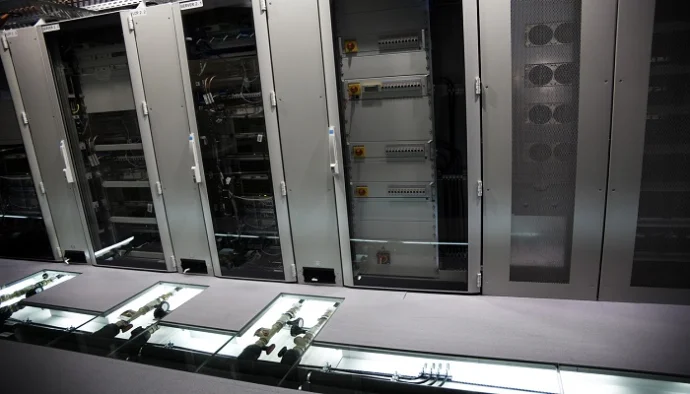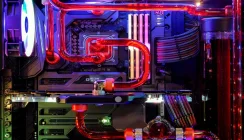Calculating Heat Loads and Computer Room Cooling Requirements
Very often IT closets, computer and server rooms are overlooked when it comes to cooling and environment monitoring and yet they can experience rapid heat build-up. One of the biggest issues is deciding how to calculate the actual cooling requirements and then how best to deliver this into the relatively small and confined spaces.
Recommended Server Room Temperatures and Humidity
Most electronic devices can operate up to 30-40˚C and server brochures and datasheet specifications may state that their devices can work up to this temperature range without derating, but the fact is that heat kills electronics.
At the higher end of their temperature operating range, cooling fans must run far quicker to move the air volume over the CPU and associated electronics. Fans are mechanical devices with bearings that will wear out and require replacement. Electronics component life will also degrade at higher temperatures.
For most people, any temperature above 27˚C becomes uncomfortable for work. The recommended temperature range for a computer or server room or datacentre is 18-27˚ and ideally 18-25˚. This lower limit is recommended for any UPS systems used within the computing environment with valve regulated lead acid (VRLA) batteries. The recommended temperature range for a UPS system with VRLA batteries is 20-25˚C.
The recommended relative humidity is 45-50%. This ensures that the room is not too dry which can lead to a build up of static electricity and not too damp which can lead to condensation build-up on colder plastic and metal surfaces.
ASHRAE, the American Society of Heating, Refrigerating and Air-Conditioning Engineers, is the leading body when it comes to cooling and humidity levels in mission critical facilities and datacentres. The organisation has proposed widening the ambient temperature environment up to 30˚C in order to improve energy efficiency.
For more information see: https://tc0909.ashraetcs.org/documents/ASHRAE%20Networking%20Thermal%20Guidelines.pdf
Whilst this higher ambient temperature would reduce the demand on cooling systems and therefore improve energy usage, it may only be suitable for larger server rooms and datacentres that can incorporate cold and/or hot-aisle containment. For smaller computer and server room installations this is not cost-effective, and the only solution is to install some form of air conditioning.
IT Closet and Computer Room Air Conditioners
How to cool servers within an IT closest, computer or server room depends on their arrangement and installation format. Most servers are installed within a server rack or placed as floor standing towers. Within this type of environment the servers are air-cooled and designed with cooling fans to draw cool air through the units, via the front panel grills and to expel the hot air via the rear panel exhaust areas.
Multiple servers may be installed along with storage devices and network switches and routers. All these items will generate a heat output that must be accommodated into the cooling requirements calculation.
Whether the servers are floor towers or rack cabinet mounted, they will require adequate air flow around them and a source of cool air. The most common approach is to install an air conditioning unit. Liquid cooling solutions are available but are more commonly used within high performance computing environments and datacentres.
The air conditioner may be wall or ceiling mounted and will be the same as commonly used within an office environment. These types of air conditioner are known as ‘split units.
Split air conditioner systems are a very efficient way to cool a room. They consist of an indoor unit connected via copper pipes to an outdoor unit or heat exchanger and compressor. The AC units are supplied with a cooled refrigerant and internal fans blow air over the evaporator coils into the room.
Heat rises and so the air conditioning unit inside the room is either ceiling-suspended or wall mounted. However, this unit will only ‘push’ cool air into the room. Inside a server rack, there could be a build-up of heat referred to as ‘hot-spots’. The airflow within the sever cabinet can be improved by using blanking panels and allowing adequate room around the individual IT components for air flow. Additional fan trays can also be installed to draw air through the server cabinet.
Due to the potential for rapid heat spikes within a confined space like a server rack or computer room, it is important to install environment monitoring. As well as for temperature and humidity, an environment monitoring system can also detect smoke, fire, and water issues if fitted with the appropriate additional sensors. For an environment monitoring system to operate effectively, the sensors must be positioned appropriately within the installation with a suitable air flow for sampling. Within a server rack this can mean up to 3 pairs of sensors (front and rear) placed on the bottom, middle and to the top of the server rack.
The use an external heat exchanger and compressor prevents a build-up of condensation inside the internal AC unit. This is one of the issues with portable AC units which will have a tray to store moisture removed from the air as it is cooled. The condenser tray will require emptying at regular intervals for the portable AC unit to continue to operate. Alternatively, portable AC units may also have an exhaust pipe that requires routing to the outside via a doorway or window; both of which provide poor seals to the environment and therefore low cooling efficiency.
Calculating Cooling Requirements
A quick rule of thumb air conditioner calculation for a room is to determine the floor area of the room in terms of the Width by the Depth in metres and to multiply this by 20 to give a British Thermal Unit (BTU) for the space.
If the space is 10 by 20 metres, the floor area = 10 × 20 = 200m²
The BTU is 200 × 20 = 4,000 BTU or 4,000 BTU per hour
In terms of an air conditioner we need to consider the BTU/hr required with 1kW = 3412 BTU/hr. The Kilowatts is therefore equal to:
4,000 / 3412 = 1.17kW of cooling required
For this application we would therefore consider the nearest sized AC unit which may be a 3 or 5kW system.
Calculating Heat Loads
Heat gain refers to the transfer of heat within an environment and there are several sources of heat gain within a computing environment which must be calculated for. These must be factored into a more accurate calculation and include:
- Floor area : as mentioned above 10 × 20 metres
- Windows: small computer rooms tend to have windows which adds to heat gain
- Room occupants: number of people in the room at any given time
- Heat generated by equipment: for servers the power capacity = the heat generated
- Electrical lighting heat: whether LED or fluorescent heat is generated by the lighting
Taking the remaining elements for the calculation after floor area we have:
Windows
If the IT closet, computer or server room has no windows then this part of the calculation can be ignored. If there are windows, then these must be factored depending on whether the windows are south or north facing.
- South Window BTU = window Width x Depth (m) x 870 then x 1.5 (if there are no blinds)
- North Window BTU = window Width x Depth (m) x 165 then x 1.5 (if there are no blinds)
The total window BTU = Southern Window BTU + Northern Window (BTU)
People (Occupants and Visitors)
It is common to allow for 400 BTU per person. The calculation is then:
The total occupant BTU = number of people in the room x 400
IT Equipment and Other Devices
For servers the power drawn in by the hardware is converted to heat by the central processing unit (CPU). Therefore a 900W server will generate 900W of heat. For this calculation it is important to list all the IT devices including switches, routers and storage devices as well as the servers. The total wattage required for say a UPS system can be taken for the cooling load in Watts or Kilowatts. For safety add a factor into the calculation of 1.5 to allow for future expansion.
IT Equipment BTU = Total wattage x 1.5
Other larger electrical systems within the room will also add to the BTU load. An example being an uninterruptible power supply. The larger the UPS in terms of kVA/kW rating, the higher the heat output. This will also vary depending on UPS load and battery charge state.
Electrical Lighting
The same process for IT equipment can be repeated for lighting. The final figure is multiplied by 4.25 to give the lighting BTU but this may be reduced by one third if LED lighting used in place of fluorescent lighting.
Lighting BTU = Total wattage for all lighting x 4.25
Total Cooling Calculation
The total cooling load is then a summation of the individual calculation as follows:
Floor Area + Window + People + IT Equipment + Lighting = Total Cooling BTU required
and to get the kW divide the Total Cooling BTU by 3412
Total Cooling BTU required / 3412 = Total Cooling kW required
Whilst this is more accurate than the ‘rule of thumb’ calculation it is still general in its approach and can again only be used as a guide. For a more accurate and complete calculation a site survey is recommended in order to factor in other site-specific characteristics and requirements and to ensure that the most appropriate cooling solution technology and correctly sized air conditioner is chosen.
Summary
Climate change continues to push demand for air conditioning and especially within computer and server rooms that may already be at the edge of their ambient temperature envelope. IT is relatively easy to improve the cooling air flow within these types of facilities if there is an existing air conditioner to upgrade. For IT facilities without an existing AC unit the server room cooling requirements must be calculated.
Whilst a quick calculation can be made, it is important for the site to be surveyed by a suitably qualified HVAC engineer and cooling specialist. Alongside any installed IT network or computer room cooling solution, it is also important to consider environment monitoring to ensure that sudden heat spikes and temperature surges generate an alarm condition that can be quickly responded to in order to ensure server uptime and business continuity.


























